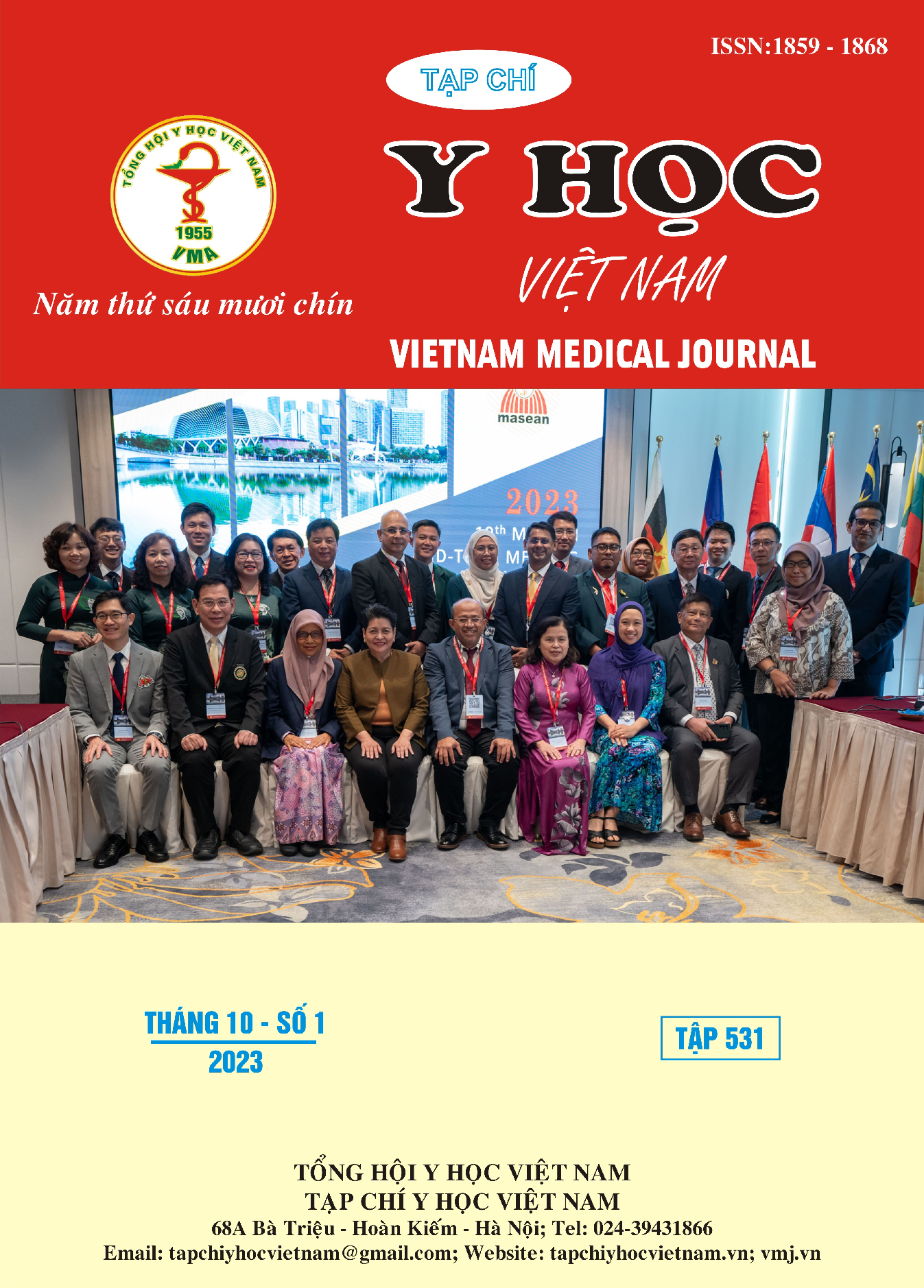EVALUATION OF THE BIOPSY RESULTS OF THE PIRADS 4 NODULES IN THE PROSTATE TRANSITION ZONE ACCORDING TO THE PIRADS V2.1 MRI CLASSIFICATION COMBINED WITH PSA DENSITY
Main Article Content
Abstract
Purpose: To evaluate the results of transrectal ultrasound-guided biopsies of PIRADS 4 nodules in the prostatic transition zone according to the PIRADS v2.1 on MRI classification in combination with density PSA. Material and methods: Retrospective descriptive study on 13 male patients who visited Hanoi Medical University Hospital from February 2019 to May 2022 due to high total PSA and/or disorders urinary. All patients underwent multiparameter magnetic resonance prostate imaging and transitional zone nodule classification according to PI-RADS v2.1. The PI-RADS 4 nodules in the transition zone would be biopsied under transrectal guided ultrasound and then compared with histopathological results and with PSA density to assess the cancer risk of this nodule group for prostate biopsy indication. Results: The mean age of the group of patients in the study was 65.1±4.4, the highest was 73 years old, the lowest was 57 years old. There were 3 patients without urinary disorders, accounting for 23%. The mean total PSA concentration in the group of patients was 20.5±11.2 ng/ml, the highest was 39.4 ng/ml, the lowest was 9.2 ng/ml. The mean prostate volume of the group of patients was 60.5±36.3 cm3, the highest was 162 cm3, the lowest was 22 cm3. The mean PSA density of the group of patients was 0.46±0.38 ng/ml/ cm3, the highest was 1.3 ng/ml/ cm3, the lowest was 0.10 ng/ml/ cm3. There were 3 patients with PSA density from 0.10-0.19 ng/ml/cm3, the remaining 10 patients have PSA density ≥ 0.20 ng/ml/ cm3. The results of prostate biopsy under the transrectal guided ultrasound showed only 6/13 patients with PIRADS 4 had cancer (accounting for 46%, of which there were 04 patients with GS=6, 01 patient with GS=7 and 01 patient with GS=8). The combination of PIRADS v2.1 classification with PSA density found that among patients with PIRADS 4 and PSA density <0.20 ng/ml/cm3, there were 2 benign patients (accounting for 67%) and 01 cancer patient (accounting for 33%). Among PIRADS 4 and PSA density≥ 0.20 ng/ml/cm3, there were 05 patients with cancer (accounting for 50%) and 05 patients without cancer (accounting for 50%). Conclusion: PI-RADS v2.1 classification on MRI played an important role in screening for prostate cancer. For PIRADS 4 nodules in transition zone, the cancer rate accounted for 46% and with PSA density threshold ≥ 0.20 ng/ml/cm3, the cancer and non-cancerous rate in the transition zone was similar.
Article Details
Keywords
PI-RADS 4 nodules, prostate transition zone cancer, PSA density.
References
2. Weinreb JC, Barentsz JO, Choyke PL et al: PI- RADS Prostate Imaging-Reporting and Data System: 2015, version 2. Eur Urol 2016; 69: 16.
3. Turkbey B, Rosenkrantz AB, Haider MA et al: Prostate Imaging Reporting and Data System version 2.1: 2019 update of Prostate Imaging Reporting and Data System version 2. Eur Urol 2019; 76: 340.
4. Boesen L, Nørgaard N, Løgager V et al. Prebiopsy biparametric magnetic resonance imaging combined with prostate-specific antigen density in detecting and ruling out Gleason 7–10 prostate cancer in biopsy-naive men. Eur Urol Oncol 2019; 2: 311–9
5. van der Leest M, Cornel E, Israel B et al. Head-to-head comparison of transrectal ultrasound-guided prostate biopsy versus multiparametric prostate resonance imaging with subsequent magnetic resonance-guided biopsy in biopsy-naive men with elevated prostate-specific antigen: a large prospective multicenter clinical study. Eur Urol 2019; 75: 570–8
6. Hansen NL, Barrett T, Kesch C et al. Multicentre evaluation of magnetic resonance imaging supported transperineal prostate biopsy in biopsy- naive men with suspicion of prostate cancer. BJU Int 2018; 122: 40–9
7. Thai JN, Narayanan HA, George AK, et al. Validation of PI-RADS version 2 in transition zone lesions for the detection of prostate cancer. Radiology. 2018;288(2):485-491.
8. Rosenkrantz AB, Kim S, Campbell N, Gaing B, Deng F-M, Taneja SS. Transition zone prostate cancer: revisiting the role of multiparametric MRI at 3 T. American Journal of Roentgenology. 2015;204(3):W266-W272.
9. Patel NU, Lind KE, Garg K et al: Assessment of PI-RADS v2 categories ≥ 3 for diagnosis of clinically significant prostate cancer. Abdom Radiol 2019; 44: 705.
10. Rosenkrantz AB, Verma S, Choyke P et al (2016) Prostate magnetic resonance imaging and magnetic resonance imaging targeted biopsy in patients with a prior negative biopsy: a consensus state- ment by AUA and SAR. J Urol 196:1613


